After circling central Virginia one time in a USPS truck, my Degen DE23 finally landed and was delivered a day early from eBay. Why spend $35 for a 13-year-old radio? The simple answer is stereo speakers with an AUX input. That’s a combo I don’t have among the 50-something radios lying about (yeah, things are getting out of hand again), and something I’d like to use to enhance the sound of some other radios, notably the Si4732 Pocket Mini.1 And it looks cool.
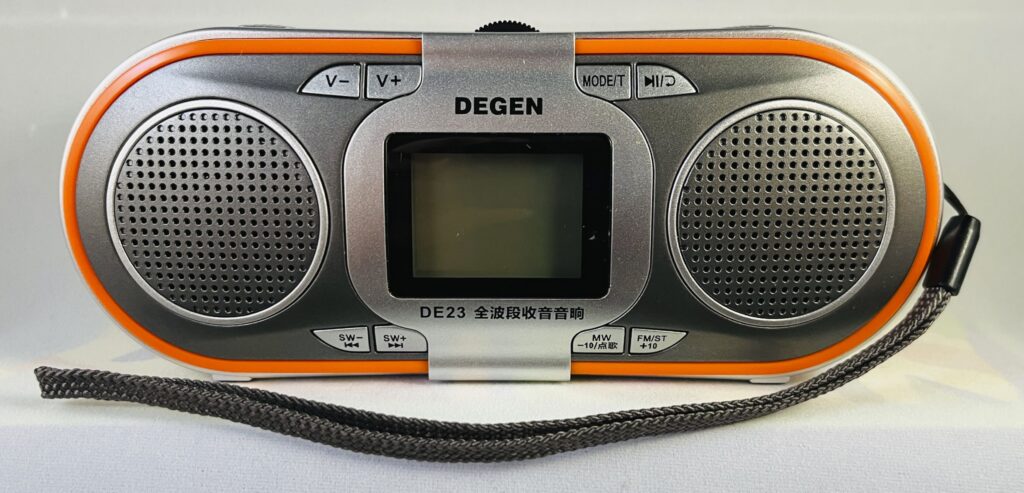
This is not a commonly-seen radio. I couldn’t find a single review for it online, nor a manual. Amazon Australia lists the radio (out of stock) but has no product reviews. I found just one YouTube video not in English. I scanned the paper manual and the result is: Degen DE23 Operation Manual.
Unboxing
Mine came in “open box” condition from eBay. It arrived in a colorful retail box with a user manual, BL-5C rechargeable battery and USB Mini cable. The radio itself is 160 x 65 x 40 mm in size (6.3 x 2.6 x 1.6 inches). The antenna is 51 mm (20 inches). Condition was very fine.

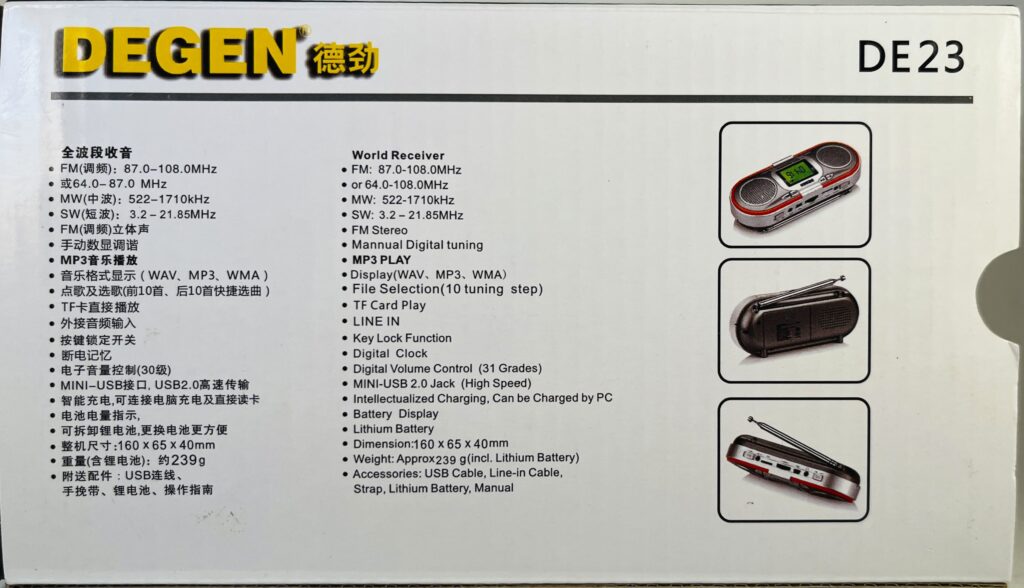

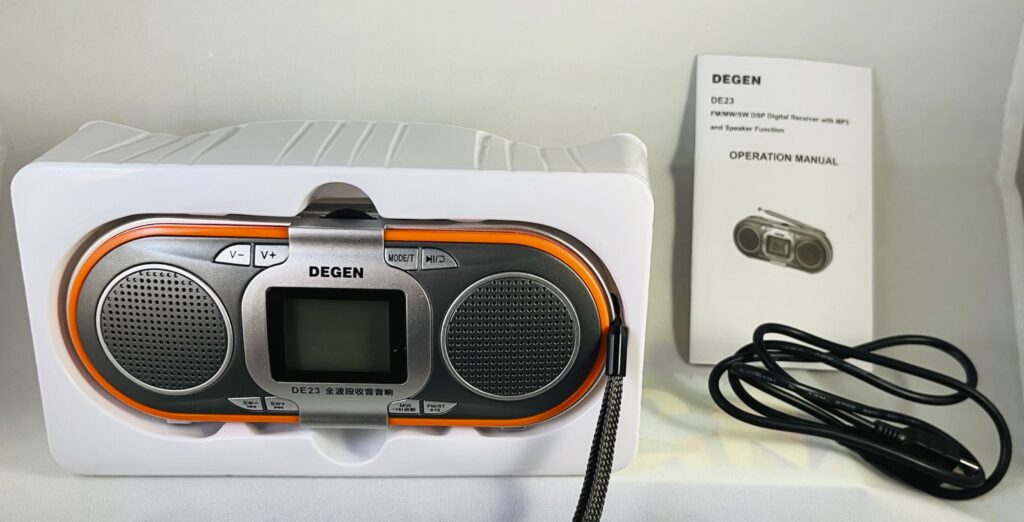
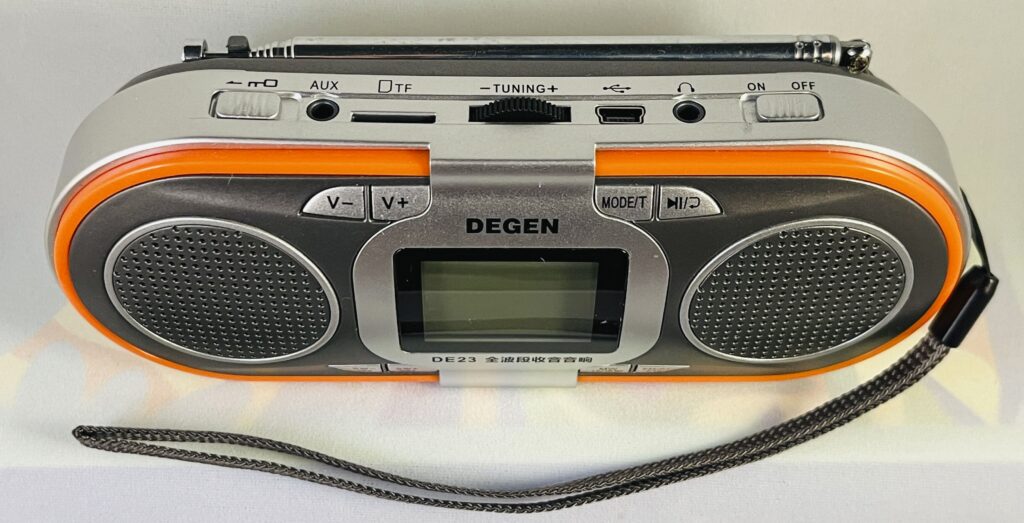
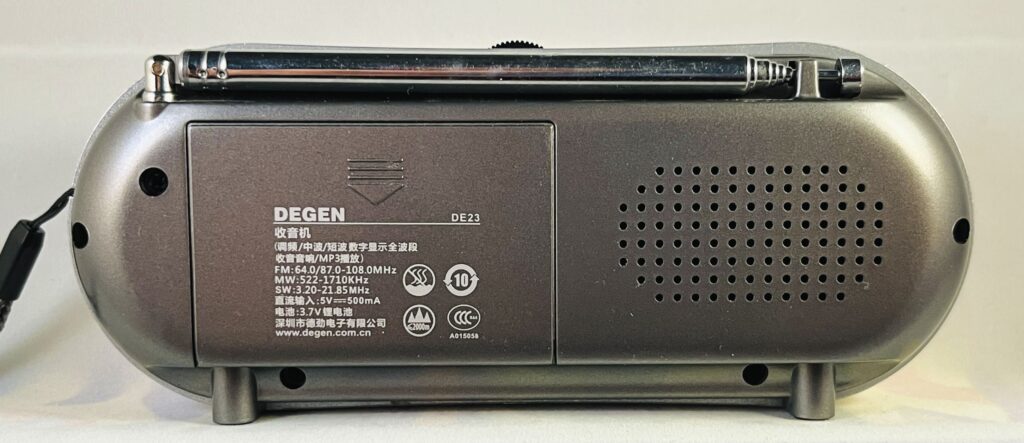
Could we start with a little panic? I flipped the the power switch and nothing happened. It’s dead, Jim. It turns out the BL-5C battery was 100% depleted. Spare installed. Now it boots. The manual says to charge the battery for 6 hours the first time, and that’s about how long it took to fully charge it.
First impressions
The first thing I noticed was the OFF/ON switch — it’s a switch, not a button, and not likely to be accidentally activated. The lock switch is similar on the left side of the radio. The lock only apples to buttons, not the power switch, nor the tuning control. The next thing is the rather prominent tuning wheel on the top. I usually prefer this to pushing buttons.
The third thing that stuck me was that when I plugged in the USB cable to my PC to see if I could get it powered up, the screen displayed PC. The DE23 knew it was connected to a computer, and indeed, a Windows computer can access files on a memory card inserted into the radio.
Finally, when I got it booted, I noticed it picked up a fair number of FM stations next to my computer. More on that later.
My next impression was that I didn’t quite know which button did what in terms of the setup, and I need to deal with that question before I can move on to the next section, because the MW channel spacing arrived set to 9 kHz. OK, let’s give the product the benefit of the doubt and check the manual. GASP! there it is, Section 8.4 under “Radio Mode: 9K/10K AM tuning steps.”
When listening to AM band, long press <MW/-10> to select 9K/10K steps. When the display shows “522”, it means 9K steps is selected; when it shows “520”, it means 10K steps is selected.
This is not your average Chinese radio manual! The setting worked, by the way.
Daytime Band Scan
As always, the Daytime Band Scan is done somewhere near midday, outdoors. For FM, the radio is handheld and waved about to get stations. MW reception is with the radio on a non-conductive table turned in a NW/SE direction and not moved during the scan. I count the station if there is clearly something there. My best radios get 22 stations on MW and 80 on FM. I don’t have much optimism that the wide case includes a correspondingly long ferrite bar antenna for MW. It will likely be small. Here’s the real result:
There were two problems with the test. The radio issued a buzz continuously on the MW band, I presume from the display electronics, that persisted on all MW frequencies whether the display was illuminated or not; it might have obscured some weak stations. FM had a problem with strong stations appearing sometimes 300 kHz on either side of the channel, thereby potentially covering up other stations.
One annoying result was that the tuning wheel sometimes skipped frequencies and one had to tune back and turn gingerly to get some of them. I believe the encoder is just a potentiometer that might work better after more use.
There are two types of encoders for radio knobs, absolute and relative. The absolute encoder works like the tuning knob of an analog radio, where the absolute position of the knob determines the frequency. The relative encoder just indicates which way the knob is turned and the radio’s circuitry increments or decrements the frequency. This radio has an absolute encoder, so if you turn to the end of a band and then switch to the next band, the radio will be tuned to the end of that band as well.
Shortwave
I haven’t tested shortwave, beyond noting that CFRX in Toronto was faintly audible with the telescopic antenna and that the radio cannot be tuned outside the international broadcast band frequencies; for example, you can’t tune WWV. I was able to receive CHU on 3330 kHz at 08:20 UTC using just the telescopic antenna.
The manual doesn’t specify the bands, but here are the ranges:
| Band | Meters | Start frequency (MHz) | End Frequency (MHz) |
|---|---|---|---|
| 1 | 90 | 3.2 | 3.4 |
| 2 | 75 | 3.9 | 4 |
| 3 | 60 | 4.75 | 5.6 |
| 4 | 49 | 5.9 | 6.2 |
| 5 | 41 | 7.1 | 7.35 |
| 6 | 31 | 9.4 | 9.9 |
| 7 | 25 | 11.6 | 12.1 |
| 8 | 22 | 13.57 | 13.87 |
| 9 | 19 | 15.1 | 15.8 |
| 10 | 16 | 17.48 | 17.9 |
| 11 | 15 | 18.9 | 19.02 |
| 12 | 13 | 21.45 | 21.85 |
Audio quality
Audio quality is important for this radio since I intend to use it as a stereo speaker. The relatively small BL-5C battery doesn’t bode for long pay times. I found the music quality for classical music (from FM) to be unexciting with not much bass. I plugged in a pair of Audio Technica ATH-M50 monitor headphones and the result was very good. For Country it was good, but no deep bass without the headphones.
I hooked the radio up to the SI4732 Pocket Mini audio output jack and found an obvious improvement, and with headphones a pleasing musical experience. Headphones don’t work plugged in directly to my version of the Pocket Mini.
Some punchy bass MP3 files I tried sounded good with more bass than radio programming.
Operation
Operation is more controlled by the buttons than menus, unlike the Degen DE28. It has a combination Mute/Return button. I always appreciate a Mute.
The mode changes to AUX speaker automatically when the AUX cable is plugged, and MP3 player mode when the memory card is plugged.
When the USB cable is connected to a PC, Windows Explorer can access media on a card plugged in to the radio and the Play/Pause button on the Radio can pause the Windows Media Player. The DE23 is also supposed to act as a computer speaker, but it didn’t work and several attempts failed to get it to work. Windows sees and loads a device driver, but marks it as not supporting audio output.
- After the announcement of the 90-day trade deal between China and the US, I ordered an upgraded SI4732 Pocket Mini that should arrive around the end of May. ↩︎
